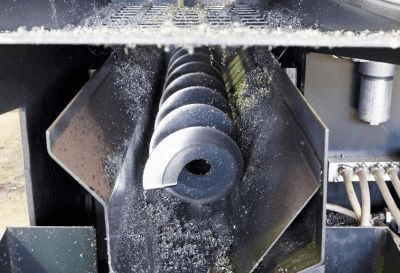What Is a Conveyor Screw?

A conveyor screw is a conveyor that can transport granular objects by rotating helical screw blades.
It does not have a feeding function, and is a product made specifically for conveying only as a conveyor. Due to its structure, it is capable of transporting at an incline, and is characterized by its resistance to contamination by foreign matter and leakage of transported materials.
Taking advantage of the features of the screw wings, which are shaped like a series of spirals, it is possible to feed two or more substances at the same time and mix and transfer them while agitating, in addition to conveying. It can be used in combination with a feeder to supply a fixed amount, or to cool and heat at the same time.
Conveyor screws are efficient, compact, and can be used as part of a complex process. They are also easily installed and removed, and mobile products are available.
Uses of Conveyor Screws
Conveyor screws are used in a variety of industries for powder conveying applications because of their simplicity of construction and efficiency.
A typical industry is the building materials industry. They are used to mix and transport raw materials such as cement, sand, water, and crushed stone for the purpose of manufacturing concrete. It is one of the main raw materials for concrete and is widely used in construction and civil engineering projects.
In the food sector, it is used to transport agricultural products such as feed and grains. In the mining industry, it is used to transport cement and coal. In some cases, they are used for ash removal from boilers.
In the chemical industry, they are used to transport granulated chemicals. One example is the transport of calcium carbonate from tanks to mixing tanks. They are also used in the pharmaceutical and other fields, where they are responsible for mixing and conveying.
Principle of the Conveyor Screws
The principle of a conveyor screw is a machine that feeds material by rotating a helically bent feed screw (screw). A conveyor screw consists of a screw, housing, and drive unit.
1. Screw (Feed Screw)
The screw is a spiral-shaped part that feeds the material. As the screw rotates, the material is pushed forward.
The screw diameter and pitch (angle of rotation of the screw) are designed according to the type and amount of material to be conveyed. By adjusting the shape and rotation speed of the screw, the amount and speed of material being pumped can be controlled.
2. Housing
The housing is a cylindrical outer shell that covers the screw. It contains the material to be transferred. The shape and size of the housing are designed according to the size of the screw and the type of material to be transferred. The material to be transferred moves inside the housing along the screw’s spiral groove.
3. Drive Unit
The drive unit, such as an electric motor or engine, is used to rotate the screw. The drive unit rotates the screw to feed the material.
In most industrial applications, three-phase induction motors are used. Among three-phase motors, 200V products are most common. By using an inverter or other device, the rotational speed of the drive unit can be varied to change the conveying speed.
How to Select a Conveyor Screw
When selecting a conveyor screw, select the appropriate equipment based on the object to be conveyed and the distance to be covered.
First, the selection should be based on the material to be conveyed, such as powder or granules. In most cases, conveyor screws are used to transport powders, so other transport methods should be considered for liquids and other materials. The shape and material of the screw differs depending on the type of material to be conveyed.
Screw size and housing size also vary depending on the amount of material to be transported. We accurately ascertain the amount of material to be conveyed and select equipment with the necessary conveying capacity.
In addition, the range of application of conveyor screw is relatively short. Depending on the distance to be conveyed, multiple conveyor screws may need to be connected. It is necessary to consider the number and arrangement of the required conveyor screws according to the distance to be conveyed.